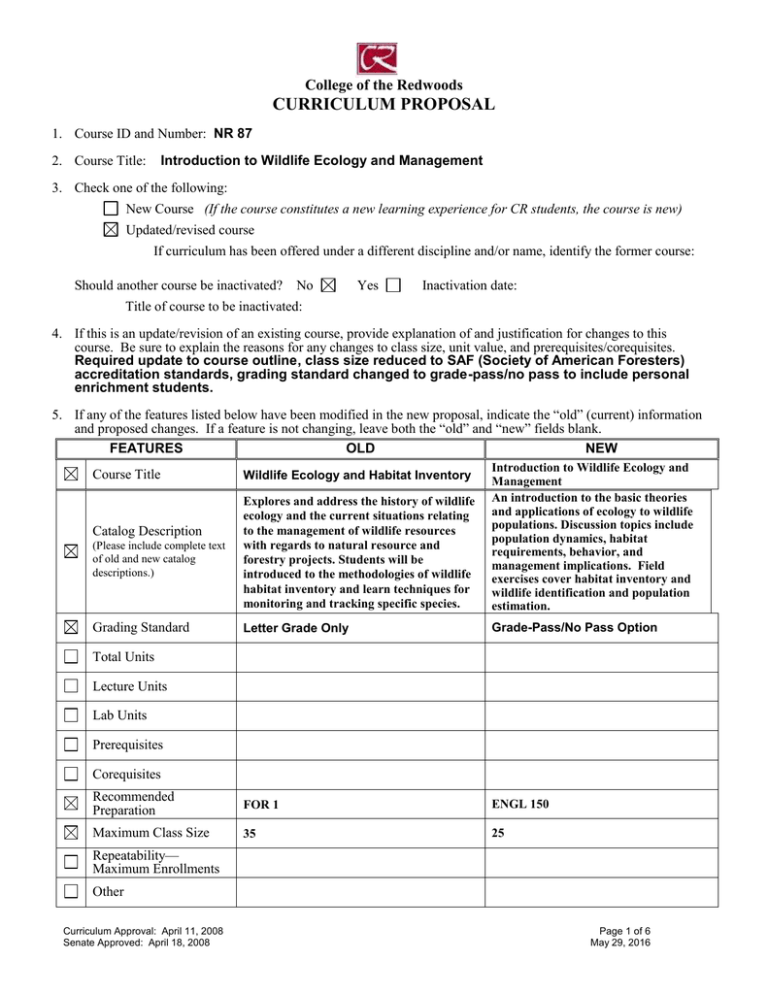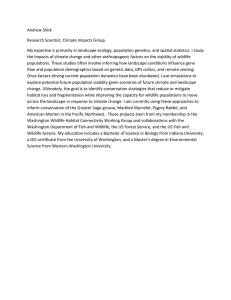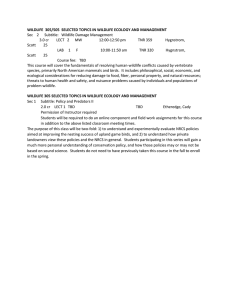CURRICULUM PROPOSAL College of the Redwoods
advertisement

College of the Redwoods CURRICULUM PROPOSAL 1. Course ID and Number: NR 87 Introduction to Wildlife Ecology and Management 2. Course Title: 3. Check one of the following: New Course (If the course constitutes a new learning experience for CR students, the course is new) Updated/revised course If curriculum has been offered under a different discipline and/or name, identify the former course: Should another course be inactivated? No Yes Inactivation date: Title of course to be inactivated: 4. If this is an update/revision of an existing course, provide explanation of and justification for changes to this course. Be sure to explain the reasons for any changes to class size, unit value, and prerequisites/corequisites. Required update to course outline, class size reduced to SAF (Society of American Foresters) accreditation standards, grading standard changed to grade-pass/no pass to include personal enrichment students. 5. If any of the features listed below have been modified in the new proposal, indicate the “old” (current) information and proposed changes. If a feature is not changing, leave both the “old” and “new” fields blank. FEATURES OLD NEW Explores and address the history of wildlife ecology and the current situations relating to the management of wildlife resources with regards to natural resource and forestry projects. Students will be introduced to the methodologies of wildlife habitat inventory and learn techniques for monitoring and tracking specific species. Introduction to Wildlife Ecology and Management An introduction to the basic theories and applications of ecology to wildlife populations. Discussion topics include population dynamics, habitat requirements, behavior, and management implications. Field exercises cover habitat inventory and wildlife identification and population estimation. Letter Grade Only Grade-Pass/No Pass Option Recommended Preparation FOR 1 ENGL 150 Maximum Class Size 35 25 Course Title Catalog Description (Please include complete text of old and new catalog descriptions.) Grading Standard Wildlife Ecology and Habitat Inventory Total Units Lecture Units Lab Units Prerequisites Corequisites Repeatability— Maximum Enrollments Other Curriculum Approval: April 11, 2008 Senate Approved: April 18, 2008 Page 1 of 6 May 29, 2016 College of the Redwoods COURSE OUTLINE . 1. DATE: 2/9/2009 2. DIVISION: Math, Science, and Engineering 3. COURSE ID AND NUMBER: NR 87 4. COURSE TITLE (appears in catalog and schedule of classes): Introduction to Wildlife Ecology and Management 5. SHORT TITLE (appears on student transcripts; limited to 30 characters, including spaces): Wildlife Ecology Mgmt 6. LOCAL ID (TOPS): 011520 (Taxonomy of Program codes http://www.cccco.edu/Portals/4/AA/CP%20&%20CA3/TopTax6_rev_07.doc) 7. NATIONAL ID (CIP): 030601 (Classification of Instructional Program codes can be found in Appendix B of the TOPS code book http://www.cccco.edu/Portals/4/AA/CP%20&%20CA3/TopTax6_rev_07.doc) 8. Discipline(s) (Select from CCC System Office Minimum Qualification for Faculty [copy following web address and paste into web browser http://www.cccco.edu/divisions/esed/aa_ir/psmq/min_qual/min_quals%20_revApr406.pdf] Course may fit more than one discipline; identify all that apply): FOR, NR 9. FIRST TERM NEW OR REVISED COURSE MAY BE OFFERED: F2009 10. TOTAL UNITS: 3 TOTAL HOURS: 90 [Lecture Units: 2 Lab Units: 1] [Lecture Hours: 36 Lab Hours: 54] (1 unit lecture=18 hours; 1 unit lab=54 hours) 11. MAXIMUM CLASS SIZE: 25 12. WILL THIS COURSE HAVE AN INSTRUCTIONAL MATERIALS FEE? No Yes Fee: $ (If “yes,” attach a completed “Instructional Materials Fee Request Form”—form available in Public Folders>Curriculum>Forms) GRADING STANDARD Letter Grade Only Pass/No Pass Only Is this course a repeatable lab course: No Yes Grade-Pass/No Pass Option If yes, how many total enrollments? Is this course to be offered as part of the Honors Program? No Yes If yes, explain how honors sections of the course are different from standard sections. CATALOG DESCRIPTION -- The catalog description should clearly describe for students the scope of the course, its level, and what kinds of student goals the course is designed to fulfill. The catalog description should begin with a sentence fragment. An introduction to the basic theories and applications of ecology to wildlife populations. Discussion topics include population dynamics, habitat requirements, behavior, and management implications. Field exercises cover habitat inventory and wildlife identification and population estimation. Special notes or advisories (e.g. field trips required, prior admission to special program required, etc.): Field trips are required; the College does not provide transportation. PREREQUISITE COURSE(S) No Yes Course(s): Rationale for Prerequisite: Describe representative skills without which the student would be highly unlikely to succeed . COREQUISITE COURSE(S) No Yes Rationale for Corequisite: Curriculum Approval: April 11, 2008 Senate Approved: April 18, 2008 Course(s): Page 2 of 6 May 29, 2016 RECOMMENDED PREPARATION No Yes Course(s): ENGL 150 Rationale for Recommended Preparation: Students will have difficulty keeping up with the reading without adequate language skills. A research project with a written report is also required for successful course completion. COURSE LEARNING OUTCOMES –This section answers the question “what will students be able to do as a result of taking this course?” State some of the objectives in terms of specific, measurable student actions (e.g. discuss, identify, describe, analyze, construct, compare, compose, display, report, select, etc.). For a more complete list of outcome verbs please see Public Folders>Curriculum>Help Folder>SLO Language Chart. Each outcome should be numbered. 1. Identify common local and regional wildlife species. 2. Assess habitat suitability for different wildlife species. 3. Collect and analyze population-related data. 4. Describe impacts of changing demographics on population health. 5. Describe basic nutritional needs for various guilds or types of animals. 6. Analyze habitat for suitable cover. 7. Discuss management strategies and implications for various wildlife species. 8. Discuss the development of wildlife policies in the U.S.A. and abroad. COURSE CONTENT –This section describes what the course is “about”—i.e. what it covers and what knowledge students will acquire. Each item should be numbered. Concepts: What terms and ideas will students need to understand and be conversant with as they demonstrate course outcomes? 1. Population dynamics, natality, fecundity, mortality, recruitment, and carrying capacity. 2. Animal behavior, territoriality, breeding selection, and dispersal behaviors. 3. The logistic population growth model. 4. Food and nutrition. 5. Cover and energy conservation. 6. Succession and community dynamics. 7. Soil fertility and wildlife breeding success. 8. Effects of forest and recreation management on wildlife populations. 9. Wildlife disease spread and impacts. 10. Agricultural chemicals and wildlife populations. Issues: What primary tensions or problems inherent in the subject matter of the course will students engage? 1. Native vs. non-native wildlife species. 2. Human manipulation of wildlife populations for economic gain. Themes: What motifs, if any, are threaded throughout the course? 1. The impacts of anthropogenic change on wildlife populations. Skills: What abilities must students have in order to demonstrate course outcomes? (E.g. write clearly, use a scientific calculator, read college-level texts, create a field notebook, safely use power tools, etc.) 1. Identify local wildlife, especially waterfowl species. 2. Use dichotomous keys to determine sex and age of waterfowl from wings. 3. Write in a scientific format. 4. Analyze and interpret habitat data. REPRESENTATIVE LEARNING ACTIVITIES –This section provides examples of things students may do to engage the course content (e.g., listening to lectures, participating in discussions and/or group activities, attending a field trip). These activities should relate directly to the Course Learning Outcomes.. 1. Listening to lectures on wildlife ecology. 2. Participating in classroom discussions on wildlife management. 3. Participating in field trips to identify local wildlife. 4. Participating in lab exercises to inventory wildlife habitat. Curriculum Approval: April 11, 2008 Senate Approved: April 18, 2008 Page 3 of 6 May 29, 2016 ASSESSMENT TASKS –This section describes assessments instructors may use to allow students opportunities to provide evidence of achieving the Course Learning Outcomes. Representative assessment tasks (These are examples of assessments instructors could use): 1. Exams. 2. Lab reports. 3. Quizzes. 4. Lab practicals. Required assessments for all sections (These are assessments that are required of all instructors of all sections at all campuses/sites. Not all courses will have required assessments. Do not list here assessments that are listed as representative assessments above.): 1. Research paper on a wildlife species of interest. 2. Comprehensive final exam. EXAMPLES OF APPROPRIATE TEXTS OR OTHER READINGS –This section lists example texts, not required texts. Author, Title, and Date Fields are required Author Bolen and Robinson Author Title Date Author Title Date Author Title Date Title Wildlife Ecology and Management 5 th Edition Date 2003 Other Appropriate Readings: COURSE TYPES 1. Is the course part of a Chancellor’s Office approved CR Associate Degree? No Yes If yes, specify all program codes that apply. (Codes can be found in Outlook/Public Folders/All Public Folders/ Curriculum/Degree and Certificate Programs/choose appropriate catalog year): Required course for degree(s) FOR.AS.Forest Technology Restricted elective for degree (s) Restricted electives are courses specifically listed (i.e. by name and number) as optional courses from which students may choose to complete a specific number of units required for an approved degree. 2. Is the course part of a Chancellor’s Office approved CR Certificate of Achievement? No Yes If yes, specify all program codes that apply. ( Codes can be found in Outlook/Public Folders/All Public Folders/ Curriculum/Degree and Certificate Programs/choose appropriate catalog year): Required course for certificate(s) FOR.CA.NR Restricted elective for certificate(s) Restricted electives are courses specifically listed (i.e. by name and number) as optional courses from which students may choose to complete a specific number of units required for an approved certificate. 3. Is the course Stand Alone? No Yes (If “No” is checked for BOTH #1 & #2 above, the course is stand alone) 4. Basic Skills: NBS Not Basic Skills 5. Work Experience: NWE Not Coop Work Experience 6. VATEA Funded Course (applies to vocational and tech-prep courses only): 7. Purpose: A Liberal Arts Sciences 8. Accounting Method: W Weekly Census 9. Disability Status: N Not a Special Class yes no CURRENT TRANSFERABILITY STATUS This course is currently transferable to Curriculum Approval: April 11, 2008 Senate Approved: April 18, 2008 Page 4 of 6 May 29, 2016 Neither CSU nor UC CSU as general elective credit CSU as a specific course equivalent (see below) If the course transfers as a specific course equivalent, give course number(s)/ title(s) of one or more currently-active, equivalent lower division courses from CSU. 1. Course , Campus 2. Course , Campus UC as general elective credit UC as specific course equivalent If the course transfers as a specific course equivalent, give course number(s)/ title(s) of one or more currently-active, equivalent lower division courses from UC. 1. Course , Campus 2. Course , Campus PROPOSED CSU TRANSFERABILITY (If course is currently CSU transferable, go to the next section): None General Elective Credit Specific Course Equivalent (see below) If specific course equivalent credit is proposed, give course number(s)/ title(s) of one or more currently-active, equivalent lower division courses from CSU. 1. Course , Campus 2. Course , Campus PROPOSED UC TRANSFERABILITY (If course is currently UC transferable, go to the next section): None General Elective Credit OR Specific Course Equivalent (see below) If “General Elective Credit OR Specific Course Equivalent” box above is checked, give course number(s)/ title(s) of one or more currently-active, equivalent lower division courses from UC. 1. Course , Campus 2. Course , Campus CURRENTLY APPROVED GENERAL EDUCATION CR CSU IGETC CR GE Category: CSU GE Category: IGETC Category: PROPOSED CR GENERAL EDUCATION Rationale for CR General Education approval (including category designation): Natural Science Social Science Humanities Language and Rationality Writing Oral Communications Analytical Thinking Curriculum Approval: April 11, 2008 Senate Approved: April 18, 2008 Page 5 of 6 May 29, 2016 PROPOSED CSU GENERAL EDUCATION BREADTH (CSU GE) A. Communications and Critical Thinking B. Science and Math A1 – Oral Communication A2 – Written Communication A3 – Critical Thinking B1 – Physical Science B2 – Life Science B3 – Laboratory Activity B4 – Mathematics/Quantitative Reasoning C. Arts, Literature, Philosophy, and Foreign Language D. Social, Political, and Economic Institutions C1 – Arts (Art, Dance, Music, Theater) C2 – Humanities (Literature, Philosophy, Foreign Language) D0 – Sociology and Criminology D1 – Anthropology and Archeology D2 – Economics D3 – Ethnic Studies D5 – Geography D6 – History E. Lifelong Understanding and Self-Development D7 – Interdisciplinary Social or Behavioral Science E1 – Lifelong Understanding D8 – Political Science, Government and Legal Institutions E2 – Self-Development D9 – Psychology Rationale for inclusion in this General Education category: Same as above Proposed Intersegmental General Education Transfer Curriculum (IGETC) 1A – English Composition 1B – Critical Thinking-English Composition 1C – Oral Communication (CSU requirement only) 2A – Math 3A – Arts 3B – Humanities 4A – Anthropology and Archaeology 4B – Economics 4E – Geography 4F – History 4G – Interdisciplinary, Social & Behavioral Sciences 4H – Political Science, Government & Legal Institutions 4I – Psychology 4J – Sociology & Criminology 5A – Physical Science 5B – Biological Science 6A – Languages Other Than English Rationale for inclusion in this General Education category: Same as above Submitted by: T. Baker Division Chair/Director: Dave Bazard Tel. Ext. 4348 Date: 2/25/2009 Review Date: CURRICULUM COMMITTEE USE ONLY Approved by Curriculum Committee: No Academic Senate Approval Date: 3.6.9 Curriculum Approval: April 11, 2008 Senate Approved: April 18, 2008 Yes Date: 2.27.9 Board of Trustees Approval Date: 4.6.9 Page 6 of 6 May 29, 2016







